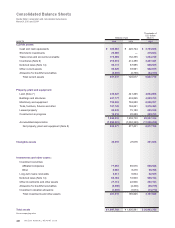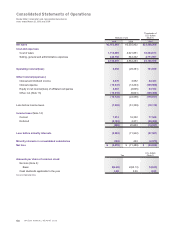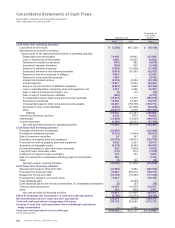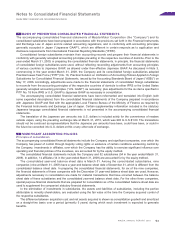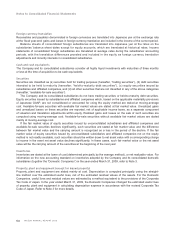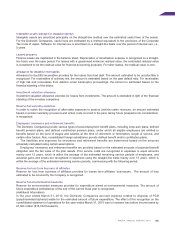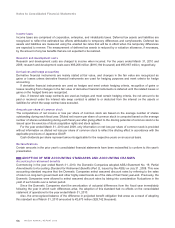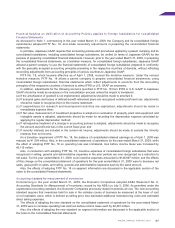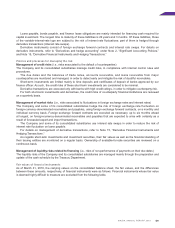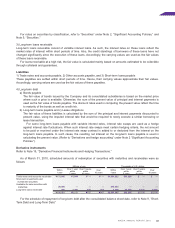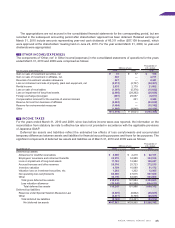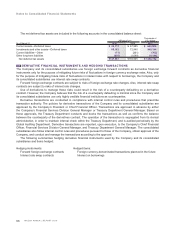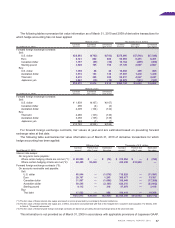Mazda 2010 Annual Report Download - page 59
Download and view the complete annual report
Please find page 59 of the 2010 Mazda annual report below. You can navigate through the pages in the report by either clicking on the pages listed below, or by using the keyword search tool below to find specific information within the annual report.
57
Practical Solution on Unification of Accounting Policies Applied to Foreign Subsidiaries for Consolidated
Financial Statements
As discussed in Note 1, commencing in the year ended March 31, 2009, the Company and its consolidated foreign
subsidiaries adopted PITF No. 18, and made necessary adjustments in preparing the consolidated financial
statements.
In principle, Japanese GAAP requires that accounting policies and procedures applied by a parent company and its
consolidated subsidiaries, including consolidated foreign subsidiaries, be unified (in terms of Japanese GAAP) for the
purpose of preparing consolidated financial statements. However, prior to the year ended March 31, 2009, in preparing
the consolidated financial statements, as a tentative measure, for consolidated foreign subsidiaries, Japanese GAAP
allowed a parent company to use the financial statements of consolidated foreign subsidiaries prepared in conformity
with the generally accepted accounting principles prevailing in the respective countries of domicile, without reflecting
reconciling adjustments from accounting principles of various countries to Japanese GAAP.
PITF No. 18, which became effective as of April 1, 2008, revised the tentative measure. Under the revised
tentative measure, PITF No. 18 allows a parent company to prepare consolidated financial statements, using
consolidated foreign subsidiaries’ financial statements which reflect adjustments to reconcile from the accounting
principles of the respective countries of domicile to either IFRS or U.S. GAAP as necessary.
In addition, adjustments for the following six items specified in PITF No. 18 from IFRS or U.S. GAAP to Japanese
GAAP should be made as necessary in the consolidation process unless the impact is immaterial:
(a) If the amortization of goodwill is not implemented, adjustments should be made to amortize it;
(b) If actuarial gains and losses of defined-benefit retirement plans are recognized outside profit and loss, adjustments
should be made to recognize them in the income statement;
(c) If expenditures for research and development activities are capitalized, adjustments should be made to
immediately expense them;
(d) If fair value measurement of investment properties is adopted or revaluation of property, plant and equipment and
intangible assets is adopted, adjustments should be made for recording the depreciation expense calculated by
applying the regular depreciation method;
(e) If retrospective treatment of a change in accounting policies is adopted, adjustments should be made to recognize
the amount as profit and loss in the current fiscal year; and
(f ) If minority interests are included in the current net income, adjustments should be made to exclude the minority
interests from net income.
As a transition requirement of PITF No. 18, the balance of consolidated retained earnings as of April 1, 2008 was
reduced by ¥1,554 million. Also, in the consolidated statement of operations for the year ended March 31, 2009, while
the effect of adopting PITF No. 18 on operating loss was immaterial, loss before income taxes was increased by
¥3,119 million.
Also, in connection with adopting PITF No. 18, incentive expenses of consolidated foreign subsidiaries that were
recognized in selling, general and administrative expenses in the prior periods are now recognized as a reduction to
net sales. For the year ended March 31, 2009, such incentive expenses amounted to ¥146,697 million, and the effects
of this change on the consolidated statement of operations for the year ended March 31, 2009 were to decrease net
sales, gross profit on sales, and selling, general and administrative expenses each by the same amount.
Also, the effects of adopting PITF No. 18 on segment information are discussed in the applicable section of the
notes to the consolidated financial statements.
Accounting standard for measurement of inventories
Commencing in the year ended March 31, 2009, the Domestic Companies adopted ASBJ Statement No. 9,
Accounting Standards for Measurement of Inventories, issued by the ASBJ on July 5, 2006. As permitted under the
superseded accounting standard, the Domestic Companies previously stated inventories at cost. The new accounting
standard requires that inventories held for sale in the ordinary course of business be measured at the lower of cost
or net realizable value, which is defined as selling price less estimated additional manufacturing costs and estimated
direct selling expenses.
The effects of adopting the new standard on the consolidated statement of operations for the year ended March
31, 2009 were to increase operating loss and loss before income taxes each by ¥2,461 million.
Also, the effects of adopting the new standard on segment information are discussed in the applicable section of
the notes to the consolidated financial statements.



